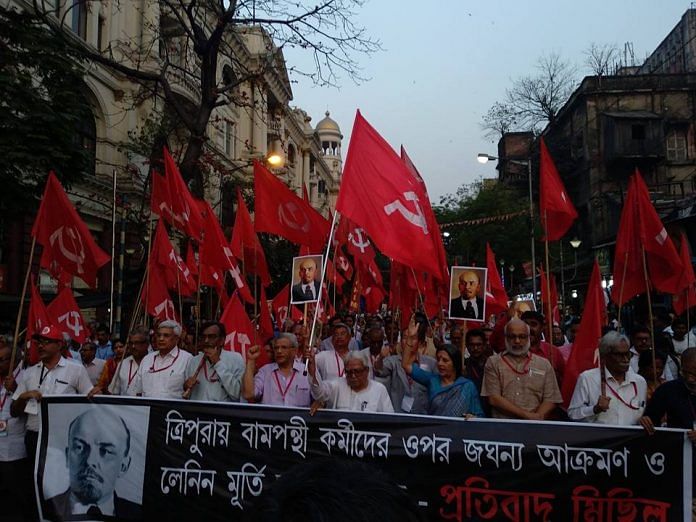The Left party will have to resolve its dilemma over whether it will have an alliance with the Congress, in a crucial meeting due in mid-April.
New Delhi: After losing the battle to defend one of its last standing citadels in Tripura, the next battle the CPI(M) will face will be internal as it tries to resolve the sharp divide within the party over what political course to adopt in the Party Congress, due in mid-April.
The conflict
The Party Congress, the CPI(M)’s highest decision making body, comes when the organisation is split in the middle over the question of whether there should be any electoral alliance or understanding with the Congress, India’s grand old party. In the central committee meeting held in January, general secretary Sitaram Yechury’s line was defeated by a vote of 31 versus 55, with the central committee adopting the draft resolution that ruled out any understanding with the Congress whatsoever, a line backed by his predecessor Prakash Karat.
Essentially, it is the party’s West Bengal unit which strongly backs Yechury’s line of keeping the option of an understanding with the Congress open. There was speculation in the party about how a loss in Tripura would influence the situation given the unit, along with former chief minister Manik Sarkar, has opposed Yechury’s line. But sources in the party say “despite pressure being put on the Tripura unit to change its stand”, it has made it clear it will stick to backing Karat’s line.
In the all-powerful 16-member politburo, as many as 11 oppose Yechury’s line. At this point, therefore, the general secretary’s position stands weakened with numbers in the Party Congress stacked against him.
This fissure in the party, however, isn’t new. In the last Party Congress in Visakhapatnam in 2015, it was in a rare nail-biting finish that Yechury was elected general secretary in a close contest with S. Ramachandran Pillai, the latter being backed by the Karat faction.
Arguments on both sides
The West Bengal faction believes BJP — the far Right — is the primary enemy and to defeat it, all ‘secular’ forces, including the Congress, must come together, an argument put forth by Yechury repeatedly. The reasoning is that a thriving BJP cannot be countered by a splintered opposition.
However, the unit’s decision to ally with the Congress in the 2016 assembly polls completely backfired, with Mamata Banerjee’s Trinamool Congress winning 211 of the 294 seats, the CPI(M)-led Left Front managing just 28 seats, less than even the 44 won by Congress.
Those opposing the West Bengal unit’s line believe this argument is fundamentally flawed since an alliance between the Congress and Left to defeat BJP does not make sense where the Left anyway isn’t relevant — north, central and western India, and where the Left is relevant, BJP isn’t even its primary enemy or alliance with Congress is pointless.
In Kerala for instance, it is the Congress which is the main rival for the Left. In Tripura, while the BJP has now clearly emerged as the main party, it has done so by completely co-opting Congress there, which means that for the Left an alliance with Congress, which now has barely 1.5 per cent vote there, makes little sense.
In West Bengal, meanwhile, the worry for sections opposing an understanding with Congress is that since TMC is the strongest pole, it will try to eventually co-opt the Congress, leaving the CPI(M) in a difficult spot.
The issue was hotly discussed in the CPI(M) state conference in West Bengal late last week and sources say sections of this unit are “also now beginning to question the feasibility of Yechury’s line”.
The road ahead
What happens in the Party Congress next month is the big question for the already embattled CPI(M). The Party Congress, which takes place every three years, is also when the general secretary is elected. At this point, it seems unlikely that Yechury’s line in its current form can prevail.
Some in the party believe that with Yechury’s line being defeated, it would be untenable for him to continue and his step-down could lead to a split with the West Bengal unit heading out. However, others say the party leadership, despite its differences, will want to prevent such a mess and for this a “face saver” or “some kind of a middle path” may be arrived at.
“It is possible that no all-India line will be adopted under the pretence of adopting an all-India line. The operative part would be to allow state-specific flexibility,” a party source said speaking on condition of anonymity.
Further, it is also the nuance of a pre-poll alliance with the Congress versus a post-poll one for the CPI(M). While it can completely rule out a pre-poll understanding, it can ill afford to do so for a post-poll scenario.
“Imagine a hypothetical situation after the Lok Sabha seats where, say, the Left gets x number of seats and the gap between the BJP and a Congress-led opposition is narrow enough to mean that the Left’s support is crucial to prevent the former from forming the government,” another party source said.
“In that case, can the CPI(M) say it won’t support the Congress? There is no question of that. It will have to support even if it means being on the same side as TMC in order to keep the BJP out,” the source added.






